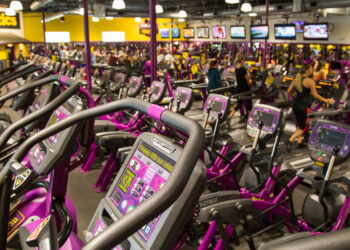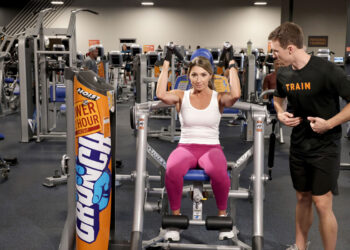A growing number of health clubs are keeping laundry in-house to control quality and reduce costs. When choosing laundry equipment, many have also turned to soft-mount washer-extractors over traditional hard-mount models. Why? Soft-mount washer-extractors produce significantly higher extract speeds than hard-mount machines, which ultimately improves production and cuts gas consumption.
Soft-Mount versus Hard-Mount – What’s the Difference?
Soft-mount washer-extractors are not only easier to install because they are freestanding, they produce extract speeds of up to 387 G-force. Conversely, hardmount washers must be bolted to concrete foundations, and only generate extract speeds of 150 to 200 G-force, according to Fritz Baenen of OPL Services, a laundry equipment distributorship in Green Bay, WI. What does that mean for an onpremise laundry? Loads, according to Baenen. “Because the soft-mount washers have such high extract, they remove considerably more water from a load,” he says. “In turn, a soft mount can cut drytime by up to 40%.” By slashing dry time, Baenen maintains production improves dramatically and gas usage decreases. Of equal importance is a soft-mount washer’s impact on labor. “Production improves using less labor,” adds Baenen. “That is the icing on the cake.”
At the Harvard Club of Boston, Athletics Director Ron Allen says the facility’s soft-mount washers significantly impact production. About five years ago, the club replaced its worn-out hard-mount washers with 55- and 30-pound capacity soft mounts. “Now our towels take only 50 minutes to wash and dry,” he says. “The washers definitely improved production. We only dry towels for 20 minutes with a full load, and we don’t need to dry them on high.”
“A major perk of soft-mount washers is that with this type of equipment, health clubs don’t need to change anything structurally,” says Ron Jansen of Laundry Pro Inc., a laundry equipment distributor in Lakeland, FL. Installations are simpler and less expensive because soft mounts don’t require concrete foundations or bolting down. This feature makes it possible to install machines almost anywhere – in small spaces, second floor rooms and on wood floors. “That’s something you can’t do with a hard mount,” adds Ralph Darling of Darling Sales and Service, an equipment distributorship in Blaine, MN. Soft mounts can be easily relocated, allowing for future expansion and alterations to the building.
Controlling Wash Quality, Turnaround & Inventory In-House
Typical health clubs wash mostly towels and occasionally, as is the case with the Harvard Club, members’ personal items. A large health club uses about 3,000 towels each day, according to Darling. “If the health club was renting towels for 22 cents, then in six months they could afford to put an on-premise laundry in,” he says. “The laundry quickly pays for itself.”
An on-premise operation allows clubs to provide quick turnaround and better service. But, is it more cost effective to operate an on-premise laundry over sending it out? Most definitely, according to Art Stiedel, assistant project manager of Bonita Bay, a 6,000-square-foot health club in Bonita Springs, FL. “It made sense to put in a laundry,” says Stiedel. “There’s no question about that.” The reliability of an on-premise laundry is unbeatable, he says, because it allows for control over both wash quality and inventory.
Allen agrees. At the Harvard Club, a fullservice city club with squash facilities, a fitness center and ample function space, the on-premise athletic laundry provides a key service to its 5,000 members – 24- hour turnaround on personal items. That means members can drop off their laundry bag of clothes and know that they’ll be clean the next day. “Sending laundry out for members would be an exorbitant cost because they’d have to distinguish one person’s items from another,” says Allen. “Here, we’ve color-coded laundry bags and it’s easy for our staff to handle their personal items. We want to provide service for our membership and ease for members to work out,” he says.
Darling and Baenen agree. “Control is key,” says Baenen. “It is important to have a quick turnaround time. Without it, health clubs need to invest in a bigger inventory or would be unable to meet the demand.”
Why Equipment Programmability is Critical
With an on-premise laundry quality is better, especially when soft mounts are used, according to Jansen, who suggests looking for a soft-mount washer that offers high programmability for more efficient operation, ease of use and superior wash quality. At the Harvard Club, different programs are used to wash towels, personals and kitchen rags. Each requires a different combination of chemicals, baths, rinses, water temperatures and extract speeds, according to Allen. The facility’s soft mounts automatically inject the appropriate amount of cleaning chemicals, at the right cycle time, water temperature, and level, based on the type of load. The automatic injection saves time by shortening the wash cycle and ensures that the right amount of detergent is used – preventing chemical overuse and damage to inventory. Operators simply touch a button to start the wash process.
An on-premise laundry used in combination with soft-mount equipment will offer health clubs the best return on investment – according to Baenen, Darling, Jansen, Allen and Stiedel – boosting production while using significantly less gas and labor. Simultaneously, an on-premise operation offers more control over inventory, turnaround time and wash quality.
Haley Jorgensen is a writer for Continental Girbau, a leading manufacturer of commercial and industrial laundry equipment. She can be contacted at 920.748.2449, or by email at haley@public-imagepr.com, or visit www.public-imagepr.com.








